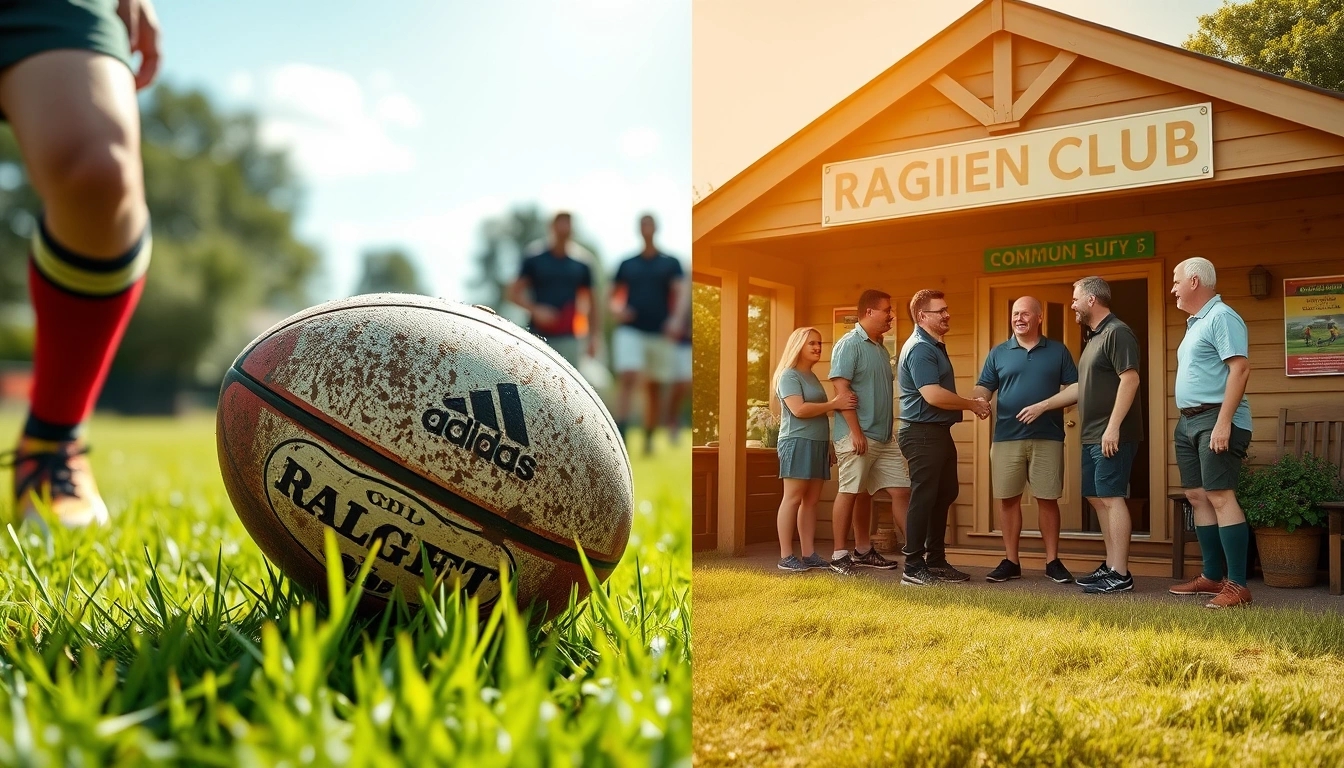Alright, so you want to jump headfirst into the world of UK grassroots rugby but feel like you’re staring at a tangled ball of string? Don’t sweat it — you’re not alone. The grassroots rugby scene might seem like a maze at first glance, but with a bit of patience and a sprinkle of curiosity, you’ll be right in the thick of it before you know it. Let’s break it down in a way that won’t make your head spin.
First off, grassroots rugby isn’t about the glitz and glamour of Premiership stadiums or international showdowns. Nope, it’s the heart and soul of rugby — the local clubs, weekend warriors, and community spirit that keep the sport alive and kicking across towns, villages, and cities. These leagues are where legends start, friendships are forged, and muddy boots are a badge of honour.
How the league system works? Well, it’s a bit like a patchwork quilt — a mix of local divisions, regional setups, and sometimes a dash of chaos thrown in for good measure. You’ve got leagues organized by geographic area, which makes sense because no one wants to travel hours for a Tuesday night match. But it’s not always straightforward. Some clubs might play in leagues slightly outside their county, or switch divisions depending on promotion and relegation. It’s a bit messy, but that’s part of the charm.
| League Level | Description | Typical Teams |
|---|---|---|
| Local Divisions | Small-scale leagues focused on towns or districts | Village teams, small town clubs |
| Regional Leagues | Larger area competitions, often county or multi-county | Established town clubs, larger communities |
| National Leagues (lower tiers) | Competitive leagues bridging grassroots and semi-pro | Top grassroots clubs, semi-professional outfits |
Now, about clubs — they come in all shapes and sizes. From a handful of mates gathering in a village green to well-oiled machines with youth setups, senior teams, and social events that could rival a festival. Each club has its own vibe; some are fiercely competitive, others just want to have fun and get a pint afterwards. The key is to find one that clicks with your personality and goals.
- Small village teams: Tight-knit, friendly, sometimes a bit rough around the edges.
- Town clubs: More structured, often with multiple teams and coaching staff.
- City clubs: Bigger squads, more resources, and a mix of casual and serious players.
If you’re new, don’t worry about being a pro right away. Grassroots rugby is famously welcoming, and most clubs have age groups from kids right up to veterans. Gender inclusivity is improving all the time, so whether you’re a bloke, a lass, or anywhere in between, there’s a spot for you.
To give you a rough idea of the season, matches usually start in early autumn, with a break in the coldest months and finishing up in spring. Training tends to be a couple of nights a week, often led by volunteers who genuinely love the game — so expect a mix of passion, patience, and maybe a few “back in my day” stories.
So, if you’re itching to get stuck in but feel overwhelmed, here’s a quick checklist to get started:
- Find your nearest club — Google and social media are your friends.
- Check out training sessions — most clubs welcome newcomers to come and watch or join in.
- Ask about fees — grassroots rugby isn’t free, but it’s usually reasonable. Expect kit costs and maybe a few extras.
- Don’t be shy — everyone was a newbie once, and most players and coaches are happy to help.
In a nutshell, grassroots rugby is about community, passion, and a bit of mud. It’s not perfect, it’s sometimes chaotic, but it’s always rewarding. So grab your boots, find a club, and dive in — the pitch is waiting.
What Exactly Are Grassroots Rugby Leagues?
Alright, let’s cut to the chase — grassroots rugby leagues in the UK aren’t about shiny stadiums or sky-high salaries. Nope, these leagues are the real heart and soul of rugby, the place where it all begins and where passion for the sport is born, nurtured, and sometimes bruised (literally). Forget the glam of the Premiership or international test matches; grassroots rugby is rugby in its rawest, most honest form.
So, what are these leagues? Simply put, grassroots rugby leagues are community-based competitions made up of local clubs, often run by volunteers, where players of all ages and abilities come together to play the game. Think muddy pitches, enthusiastic cheers from the sidelines, and a mix of players who might be juggling jobs, families, or just a genuine love for a good old-fashioned scrum.
| Key Features of Grassroots Rugby Leagues | Why It Matters |
|---|---|
| Local Clubs – Teams are usually from towns, villages, or neighborhoods. | Builds community spirit and local pride. |
| Volunteer-Driven – Coaches, referees, and organisers are often unpaid enthusiasts. | Keeps the sport accessible and affordable. |
| Inclusive – Open to a wide range of ages, genders, and skill levels. | Encourages participation and diversity. |
| Development Focused – Emphasis on learning and enjoyment over winning. | Creates a supportive environment for newbies and veterans alike. |
Now, you might wonder why these leagues matter so much when the pros get all the headlines. Well, grassroots rugby is where future stars first lace up their boots, but more importantly, it’s where rugby’s community fabric is woven. It’s a place where lifelong friendships are forged over post-match pints, where parents become coaches, and where the love of the game is passed down like a cherished family heirloom.
- Purpose: To provide regular, organised rugby for players outside the professional sphere.
- Accessibility: Making rugby available to anyone with a bit of grit and a decent pair of boots.
- Community Impact: Strengthening local bonds and promoting healthy lifestyles.
Sure, it’s not all sunshine and rainbows. Facilities can be basic, funding is often tight, and sometimes the organisation can be a bit of a jumble (who hasn’t turned up to the wrong pitch or forgotten their kit?). But that’s part of the charm — it’s real, it’s gritty, and it’s where the true spirit of rugby lives.
So, if you’re thinking about diving into the rugby world but feel a bit intimidated by the professional scene, grassroots leagues are your best bet. They’re welcoming, full of character, and offer a chance to play the game for the love of it — no fancy contracts or million-pound deals needed.
Grassroots Rugby Leagues at a Glance:- Local, community-based teams- Volunteer-led coaching and management- Inclusive across all ages and skill levels- Focused on development and enjoyment- The foundation of rugby culture in the UK
In a nutshell, grassroots rugby leagues are the beating heart of the sport in the UK. They might not grab the headlines, but without them, rugby would lose its soul. So next time you hear about a big match on TV, spare a thought for the muddy pitches and passionate players who keep the game alive, week in, week out.
How the League Structure Actually Works
Trying to make sense of grassroots rugby leagues in the UK? Well, buckle up, because it’s a bit like trying to untangle your headphones after a jog—messy, confusing, but oddly fascinating once you get the hang of it. Unlike the neat, tidy professional leagues you see on TV, grassroots rugby is a sprawling beast, full of quirks, overlaps, and local flavour.
First off, don’t expect a simple ladder where every team fits perfectly into a neat box. The structure is more like a patchwork quilt, stitched together from local divisions, county setups, and regional leagues. At the heart of it, you’ve got local leagues—these are the grassroots of grassroots, where village teams, small towns, and community clubs battle it out. These leagues are usually split geographically to keep travel reasonable (because no one wants a 3-hour trip for a Saturday morning kick-off).
| Level | Typical Scope | Examples |
|---|---|---|
| Local Divisions | Neighbourhoods, villages, small towns | South West Counties League, London 3 North West |
| County Leagues | Wider county areas | Devon League, Yorkshire 2 |
| Regional Leagues | Several counties grouped | Midlands 1 East, South West Premier |
Now, here’s where it gets a bit fuzzy: the way these leagues interconnect can vary wildly. Some counties have their own league systems, others feed into regional leagues, and occasionally teams jump between leagues due to promotions, relegations, or just administrative reshuffles. It’s not always crystal clear which league a club will end up in year-to-year, which can drive newcomers nuts.
- Promotion and Relegation: Teams can move up or down based on how well they play, but the criteria might differ by region.
- League Restructuring: Every now and then, governing bodies shuffle the leagues to balance competition or reduce travel.
- Exceptions and Appeals: Sometimes clubs appeal their league placement, adding another layer of unpredictability.
So, what keeps this all ticking? The Rugby Football Union (RFU) oversees the big picture, but much of the on-the-ground organisation is handled by county unions and volunteer committees. It’s like a giant community jigsaw puzzle, where everyone chips in to keep the game alive and kicking.
The takeaway? Don’t expect a perfect system. Grassroots rugby leagues are a living, breathing organism—sometimes chaotic, often brilliant, and always full of character. If you’re new, just remember: it’s less about the rigid structure and more about the passion on the pitch.
And if you’re wondering why it’s not as straightforward as pro leagues, well, grassroots rugby is about accessibility, community, and keeping the sport alive in every nook and cranny of the UK. That means flexibility sometimes trumps neatness, and that’s part of the charm.
In short, the league structure might look like a hot mess on paper, but on the field, it’s where rugby’s heart beats the loudest. So, grab your boots, find your local club, and dive into the wonderfully unpredictable world of grassroots rugby.

Getting to Know the Clubs: Big, Small, and Everything In-Between
So, you’re diving headfirst into the wild world of UK grassroots rugby, huh? Well, buckle up, because the clubs you’ll encounter are as diverse as the players themselves. From the tiniest village teams where the pitch might be more mud than grass, to bustling town clubs that feel like mini rugby factories, each has its own quirky charm and rugby culture that’s worth getting to know.
Let’s start small — and I mean really small. Picture a village team with barely a dozen players, some of whom probably grew up together, went to the same school, and maybe even share the same grandad’s stories about the “good old days.” These clubs often have that tight-knit, family vibe where everyone chips in, whether it’s washing the kit or manning the BBQ on match day. The rugby here might not be slick, but the passion? Off the charts. These clubs are the heartbeat of their communities, where the sport is as much about social bonding as it is about rucking and mauling.
| Type of Club | Typical Size | Culture & Atmosphere | Challenges |
|---|---|---|---|
| Village Teams | Small (10-30 players) | Close-knit, community-driven, family atmosphere | Limited resources, fewer training sessions, smaller talent pool |
| Town Clubs | Medium to Large (50-150 players) | Competitive, diverse, structured programs | Balancing growth and community feel, managing larger squads |
| City-Based Clubs | Large (150+ players) | Highly competitive, professional vibe, extensive facilities | Less personal, more pressure to perform, complex logistics |
Now, flip the coin to bustling town clubs. These bad boys usually have a more formal setup — multiple teams across age groups, dedicated coaches (sometimes even paid ones), and a calendar packed with fixtures and events. The culture here is a bit more competitive, but don’t get it twisted; there’s still plenty of room for fun and social shenanigans. Town clubs often act as a bridge between grassroots passion and stepping up towards semi-pro or professional levels.
Oh, and then there are the city-based clubs. These giants boast sprawling facilities, a ton of players, and often a more intense rugby culture. It’s where you might find future stars honing their skills or seasoned veterans passing on wisdom. The atmosphere can sometimes feel a bit like a conveyor belt — players come, players go — but the level of play and organization is usually top-notch. If you’re after structure and serious rugby development, these clubs are the go-to.
- Unique Traditions: Some clubs have weird but wonderful rituals — like the annual “mud bath” game or the infamous post-match karaoke sessions that no one remembers clearly the next day.
- Community Engagement: Many clubs run youth programs, charity events, and social nights, making them pillars of their local areas.
- Volunteer Spirit: Don’t underestimate the army of volunteers keeping these clubs afloat — from referees to groundskeepers, they’re the unsung heroes.
So, what makes each club unique? It boils down to people and place. The history, the local culture, and the personalities involved shape every scrum and line-out. Whether you’re lacing up for a village pitch or a city stadium, you’re stepping into a story much bigger than just the game.
Tips for Choosing Your Club:- Visit a few clubs to get a feel for their vibe.- Don’t be shy — ask about training schedules, social events, and support for beginners.- Consider what you want: social fun, competitive play, or skill development.- Remember, it’s okay to try a club and then switch if it doesn’t feel right.
In the end, grassroots rugby clubs are more than just teams — they’re communities, schools of life, and sometimes, a second family. So, pick your spot, grab your boots, and get ready for a rugby journey that’s as unpredictable as a last-minute try. Cheers!
Who Can Play? Age Groups and Eligibility Rules
Alright, so you’ve decided to give grassroots rugby a whirl, but before you lace up those boots and charge onto the field, there’s a bit of a maze to navigate when it comes to who’s actually allowed to play. It’s not just a free-for-all where anyone with a pulse can jump in. Nope, there are some rules, quirks, and age brackets that might trip you up if you’re not paying attention. Let’s break it down without the jargon and get you sorted.
First off, age groups are the backbone of grassroots rugby eligibility. The sport is super keen on making sure players are matched with others of a similar age and development level. This means you’ll usually find leagues divided into categories like Under-7s, Under-11s, Under-15s, and so on, all the way up to adults. It’s not just about fairness; it’s also about safety. Rugby’s a contact sport, after all, and nobody wants a 10-year-old getting steamrolled by a 17-year-old.
- Younger kids (typically under 12) often play non-contact versions like tag or touch rugby to keep things fun and safe.
- Teens move into full contact rugby but still within strict age brackets.
- Adults usually start from 18+, but some clubs have veteran leagues for the over-35s or over-50s who still want to get stuck in.
Now, onto gender inclusivity — grassroots rugby in the UK has made huge strides here. While many clubs still run separate male and female teams (thanks to physical differences and competition standards), there’s a growing push to welcome everyone. Mixed teams are common at younger age groups, and some clubs are super proactive about creating safe spaces for women and non-binary players. Don’t be shy about asking a club what their setup is; you might be pleasantly surprised!
| Category | Age Range | Typical Rules | Notes |
|---|---|---|---|
| Mini Rugby | U7 – U12 | Non-contact (tag/touch) | Focus on fun and skills |
| Junior Rugby | U13 – U18 | Full contact with safety gear | Strict age-grade competitions |
| Adult Rugby | 18+ | Full contact, competitive | Includes men’s, women’s, and vets leagues |
But wait, it’s not just age and gender — eligibility can get a bit funky with residency and club affiliation rules. Some leagues require players to live within certain areas or be registered with a club for a minimum period before playing. This is to stop “ringers” (players brought in just to win matches) and keep competition fair. Plus, if you’re switching clubs mid-season, there might be a waiting period or paperwork to sort out, so don’t expect to just turn up and play immediately.
Also, for the newbies, remember that rugby’s got a few unique quirks: you can’t just turn up in your trainers and shorts. Clubs usually expect you to register officially, which might mean filling out forms, paying fees, and getting a medical check. Don’t sweat it — it’s all standard stuff, but it’s better to know upfront than get caught out on match day.
Pro Tips for Eligibility:- Check the club’s age group cutoff dates carefully (they can vary).- Ask about mixed-gender teams if that’s important to you.- Confirm residency or registration rules early.- Don’t forget to get a proper medical cleared if needed.
So, in a nutshell: who can play? Pretty much anyone, but with some sensible boundaries to keep the game safe, fair, and enjoyable for all. Don’t let the rules scare you off — once you’re in, the spirit of grassroots rugby is all about community, support, and having a laugh while smashing into a few tackles.
Ready to find your spot on the pitch? Just remember to double-check those eligibility bits first — it’ll save you a headache or two and get you straight into the thick of the action.
Typical Season Timeline: When and How Matches Happen
Alright, let’s dive headfirst into the somewhat chaotic, yet charming world of grassroots rugby seasons. If you’re picturing a neat, tidy calendar with everything laid out like clockwork, well, you’re in for a surprise. Grassroots rugby in the UK tends to march to its own beat, and understanding when the season kicks off, takes a breather, and finally calls it a day is more of an art than a science.
Season Kick-Off: Most grassroots rugby seasons typically get underway in early September. This is when players dust off their boots, clubs scramble to finalize squads, and the air buzzes with a mix of excitement and “hope we don’t get rained out” anxiety. The start isn’t always glamorous—think muddy pitches, unpredictable weather, and sometimes, a few last-minute cancellations. But hey, that’s part of the charm!
| Month | Typical Activity | Notes |
|---|---|---|
| September | Season begins, first league matches | Weather can be unpredictable; early enthusiasm high |
| December | Short winter break | Matches pause around Christmas and New Year |
| January – March | Season resumes, league matches continue | Cold, wet conditions common; pitch quality varies |
| April – May | Season wraps up, playoffs or finals | Some leagues end earlier; weather improves |
Now, don’t get too comfortable thinking there’s a universal schedule. Some leagues start a tad earlier or later, depending on region and weather. For instance, northern clubs might battle through harsher winters, leading to more frequent postponements. Meanwhile, southern teams sometimes sneak in a few friendlies during the off-season to keep sharp.
Mid-Season Breaks and Quirks: Here’s where it gets interesting. Unlike professional leagues with strict calendars, grassroots rugby often includes unexpected breaks. These can be due to weather, pitch availability, or local events. Ever heard of a match postponed because the village fete took over the pitch? It happens more than you’d think!
- Winter Break: Usually a couple of weeks over Christmas and New Year, giving everyone a breather (and a chance to recover from festive indulgences).
- Weather Delays: Rain, snow, or frozen ground can cause last-minute cancellations. Clubs try to reschedule, but sometimes matches just get scrapped.
- Local Tournaments: Occasionally, clubs pause league action for regional cups or charity matches, adding a bit of spice to the season.
By the time April or May rolls around, most leagues are scrambling to wrap things up. Finals, playoffs, or just the last few league games bring a sense of urgency and excitement. But don’t expect a grand finale every year—some leagues quietly end, leaving players already dreaming of next season.
Pro Tip: Always check your club’s noticeboard or website regularly.Schedules can change overnight, and you don’t want to turn up to an empty pitch!
So, if you’re new to grassroots rugby, remember this: flexibility is your friend. The season might not run perfectly smooth, but that’s part of what makes grassroots rugby so endearing. It’s community-driven, unpredictable, and full of stories that professional leagues just can’t replicate.
In short, the grassroots rugby calendar is less a rigid timetable and more a living, breathing beast—sometimes messy, occasionally frustrating, but always full of heart.

Costs and Fees: What You’re Really Paying For
Jumping into grassroots rugby in the UK? Well, before you lace up your boots and hit the pitch, there’s this little thing called money to think about. And no, it’s not just the obvious stuff like club fees or buying a kit. There’s a whole sneaky bunch of extras that can catch you off guard if you’re not careful. So, let’s unpack this financial rugby ball and see what you’re really signing up for.
First up, the club fees. These usually cover your registration, insurance, and a chunk of the running costs for the club. Don’t expect it to be dirt cheap—clubs have to pay for pitch maintenance, league affiliation fees, referees, and sometimes even post-match tea and biscuits (yes, seriously). Typical fees can range anywhere from £50 to £150 a season, but it varies wildly depending on the club’s size and location. Smaller village clubs might be on the cheaper side, but don’t be surprised if town or city clubs charge more.
| Cost Item | Typical Price Range | What It Covers |
|---|---|---|
| Club Membership Fee | £50 – £150 | Registration, insurance, pitch upkeep |
| Kit & Equipment | £40 – £100+ | Jersey, shorts, socks, boots |
| Extras & Social Events | £10 – £50+ | Team socials, fundraising, travel costs |
Now, about that rugby kit. Sure, you can rock up in any old sportswear for training, but match day demands the full ensemble: jersey, shorts, socks, and boots. If you’re lucky, your club might lend you a jersey for the first few games, but most likely, you’ll have to buy your own. And don’t forget the boots! Rugby boots aren’t your average trainers; they have studs, and they ain’t cheap. Expect to drop at least £40-£50 on decent boots, and that’s being modest.
But wait, there’s more! Extras are the sneaky little costs that newbies often overlook. Think about things like travel expenses if your club plays away games, which can add up quickly if you’re not carpooling. Then there’s the occasional fundraising events or social nights—some clubs rely heavily on these to keep the lights on and the pitches playable. If you’re the social butterfly type, that might be a welcome cost, but if you’re just there to play, it can feel like an unexpected hit to your wallet.
- Training fees: Some clubs charge extra for coaching sessions, especially if they bring in specialist coaches.
- Medical checks: A few clubs require a basic health screening before you play, which might not be free.
- Personal gear: Mouthguards, tape, and other protective equipment are often your responsibility.
So, what’s the takeaway here? Grassroots rugby isn’t free, but it’s rarely extortionate either. The key is to ask questions upfront—don’t just nod along when the club rep mentions “fees.” Get the full breakdown so you’re not hit with surprise costs mid-season. And remember, the money you put in goes towards keeping the sport alive and kicking at the community level, which is pretty cool when you think about it.
In short: be prepared, budget wisely, and don’t let the costs scare you off. Grassroots rugby is about passion, community, and a bit of mud on your boots—not just the price tag.
Training and Coaching: What to Expect at Grassroots Level
If you’re stepping into the world of grassroots rugby, brace yourself for a coaching experience that’s a bit like a patchwork quilt — stitched together by passionate volunteers rather than fancy-paid pros. Yes, most coaches here are folks who juggle day jobs, family, and their love for rugby, all while trying to keep the training sessions running smoothly. Don’t expect slick professional setups or high-tech gyms; instead, think muddy fields, enthusiastic shouts, and a genuine desire to see players improve and, most importantly, have fun.
- Volunteer-driven coaching: The backbone of grassroots rugby. Coaches are often parents, ex-players, or local enthusiasts who give their time freely. Their motivation? A love for the game and community spirit, not a paycheck.
- Training intensity: It’s a mixed bag. Some sessions push players hard, focusing on fitness and skills, while others are more chill, aimed at keeping things enjoyable and inclusive.
- Focus on development over perfection: Forget about flawless tackles or perfect scrums. The priority is learning, growth, and ensuring everyone feels welcome, regardless of skill level.
Now, let’s not sugarcoat it — training can sometimes be a bit chaotic. Imagine a group of kids or adults all trying to learn the same drill, but with varying levels of experience and fitness. Coaches often have to think on their feet, adapting drills on the spot or switching gears when things aren’t clicking. It’s messy, yes, but that’s part of the charm.
| Aspect | What to Expect | Why It Matters |
|---|---|---|
| Coach Background | Mostly volunteers, some ex-players, parents, or local enthusiasts | Creates a community vibe, but coaching quality can vary |
| Training Frequency | Usually 1-2 sessions per week, evenings or weekends | Balancing rugby with work/school commitments |
| Training Focus | Basic skills, fitness, teamwork, and fun | Builds a solid foundation without pressure |
| Facilities | Local fields, community halls, minimal equipment | Accessible but sometimes limited resources |
One thing that often surprises newcomers is just how much emphasis is placed on fun and camaraderie. Coaches know that if players aren’t enjoying themselves, they won’t stick around. So, expect drills that sometimes look more like games, plenty of encouragement, and a general atmosphere that’s more about smiles than scoreboards.
Still, don’t mistake the relaxed vibe for a lack of ambition. Many grassroots clubs pride themselves on nurturing talent and instilling core rugby values. You’ll find coaches who push players to improve, but they do so with patience and understanding. After all, the goal is to develop well-rounded players who love the sport, not pressure them into early burnout.
Tips for New Players at Grassroots Training:- Don’t worry if you’re not a pro; everyone starts somewhere.- Show up with a positive attitude and be ready to learn.- Ask questions — coaches love engaged players.- Bring water, proper gear, and a sense of humor.- Remember, it’s about progress, not perfection.
In short, grassroots rugby training is a warm, sometimes chaotic, but ultimately rewarding experience. It’s where lifelong friendships form, skills are honed (slowly but surely), and the love for rugby takes root — all wrapped up in a community spirit that’s hard to beat. So lace up your boots, expect the unexpected, and get ready to dive into a rugby journey that’s as much about people as it is about the game.
Match Day: The Rituals, the Chaos, and the Community Spirit
Okay, so you think you know what a rugby match day is all about? Well, strap in, because grassroots rugby match days are a whole different beast compared to the professional stuff you see on TV. It’s messy, it’s loud, it’s full of nerves, laughs, and yeah, sometimes a bit of chaos — but that’s exactly where the magic happens.
First off, the pre-game nerves are real. You’ll see players pacing, stretching, and maybe even muttering to themselves like it’s some kind of ritual. It’s not just about warming up the muscles; it’s about getting your head in the game. And let’s be honest, for many, it’s their first time playing in front of a crowd (even if that crowd is mostly made up of parents and the local dog-walker). You’ll catch the captain rallying the troops, last-minute tactical whispers, and the odd “don’t trip over” joke that somehow breaks the tension.
- Kit checks: Are your boots tied? Shorts tucked in? Mouthguard in place? This is where you realise you forgot your socks. Classic.
- Warm-up drills: Jogging, passing drills, maybe a bit of shouting to psych yourself up.
- Team huddle: The pep talk — sometimes inspiring, sometimes just a quick “let’s not get smashed” plea.
| Match Day Timeline | What Happens |
|---|---|
| 1-2 hours before kickoff | Arrival, kit prep, warm-ups, team talk |
| Kickoff | Action begins, adrenaline spikes |
| Halftime | Water, quick tactics, catching breath (and sometimes a sneaky biscuit) |
| Full-time | High-fives, shaking hands, post-match banter begins |
| Post-match | Socialising over pints, sharing laughs, and recounting the “try that got away” |
Now, the match itself is a whirlwind. Unlike the polished pro games, grassroots rugby is a bit rough around the edges. You’ll see players giving it their all, sometimes tripping over the ball or each other, but always with heart. The refs? Often volunteers who’ve been around the block, trying to keep order while dodging flying mud and the odd sarcastic shout from the sidelines.
And then there’s the social side — the real glue that holds it all together. After the final whistle, the pitch empties but the clubhouse fills up. It’s tradition to grab a pint (or two) and swap stories about the game. Whether you scored a cracking try or just managed not to faceplant, everyone’s a hero here. This post-match ritual is where friendships are forged, new players welcomed, and the day’s frustrations washed away.
- Why the social bit matters: It’s not just about rugby; it’s about community. You’ll meet lifelong mates, get coaching tips, and maybe even hear some hilarious tales of past disasters on the pitch.
- Expect the unexpected: Someone might break into an impromptu song, or there’ll be a heated debate about a dodgy referee call — all part of the charm.
In short, a grassroots rugby match day is a rollercoaster of emotions — nerves, adrenaline, sweat, laughter, and camaraderie. It’s far from perfect, often chaotic, but always genuine. If you’re thinking of diving in, just remember: it’s not just the game you’re signing up for, but a whole community ready to welcome you with open arms (and maybe a pint).
So, lace up, show up, and get ready for a day full of passion, mud, and memories.

Common Challenges for Beginners and How to Overcome Them
Jumping into grassroots rugby as a newbie can feel like being thrown into the deep end without a floatie. You’re buzzing with excitement, maybe a bit nervous, and suddenly confronted with a whole new world that’s not just about running with a ball. There’s a steep learning curve and a few classic hurdles that nearly every rookie stumbles over. Let’s unpack those and toss in some handy tips to keep you from feeling totally lost.
The Fitness Shock
You might think, “Hey, I’m fairly active,” but rugby’s a different beast. The game demands bursts of speed, strength, and endurance that can leave you gasping for air faster than you expected. It’s not just jogging around the pitch — it’s full-contact, high-intensity sprints, tackles, and scrums. Many beginners hit a wall in the first few weeks, feeling wiped out or sore in muscles they didn’t even know existed.
- Tip: Start slow with some basic cardio and strength exercises before the season kicks off. Even a couple of weekly sessions focusing on stamina and core strength can make a world of difference.
- Tip: Don’t be shy about telling your coach if you’re struggling. They’ve seen it all and can help tailor training to your level.
Understanding the Rules (Or Not)
Rugby’s rulebook might as well be a novel for all the jargon and nuances it contains. Offside lines, rucks, mauls, lineouts — it’s a lot to take in. Beginners often feel overwhelmed trying to keep up with what’s allowed and what’s a penalty. And the whistle blows so fast, you barely get a chance to catch your breath, let alone process what just happened.
| Common Confusing Terms | Quick Explanation |
|---|---|
| Ruck | When players from both teams bind over the ball on the ground to try and win possession. |
| Maul | When the ball carrier is held up but not tackled to the ground, and teammates bind around to push forward. |
| Offside | Being in front of a teammate who last played the ball, which can lead to penalties. |
Tip: Don’t expect to master the rules overnight. Watch games, ask questions, and maybe keep a little cheat sheet handy during training.
Social Jitters and Team Dynamics
Joining a club isn’t just about playing rugby; it’s about becoming part of a community. But for many, the social aspect can be intimidating. Walking into a locker room full of seasoned players who’ve known each other for years can feel like crashing a party uninvited.
- Tip: Arrive early to training or matches to chat with teammates — most are friendly and remember what it’s like to be the new kid.
- Tip: Get involved in club socials or volunteer for small tasks. It’s a great way to bond without the pressure of performance.
Equipment and Costs
Surprise! Rugby isn’t free. Newbies often underestimate the costs involved — from boots and mouthguards to club fees and travel expenses. It can be a bit of a shock when you realize it’s not just about showing up.
Typical Costs Breakdown:- Club membership: £50-£150 per season- Kit (boots, shorts, jersey): £60-£120- Protective gear (mouthguard, headgear): £15-£40- Travel expenses: varies by location
Tip: Check if your club offers second-hand gear or kit loans. Many grassroots clubs are surprisingly supportive when it comes to easing financial burdens.
So, while grassroots rugby can throw a few curveballs at beginners, remember it’s all part of the journey. Everyone starts somewhere, and stumbling blocks are just stepping stones in disguise. Lace up, keep your chin up, and enjoy the ride — the rugby family is waiting to welcome you in.
The Role of Volunteers and Why They’re the Unsung Heroes
Alright, let’s get real for a second. When you think of grassroots rugby, your mind probably jumps to the players charging down the pitch, the occasional spectacular try, or that nail-biting last-minute penalty. But behind all that action? There’s a whole army of volunteers working their socks off to keep the wheels turning. And honestly, without these legends, grassroots rugby would be about as lively as a pub on a Monday morning.
Volunteers are everywhere: referees blowing their whistles in the rain, club admins juggling emails and registrations, coaches who probably have zero formal training but endless passion, and the folks manning the tea and bacon rolls on match day. It’s a mixed bag of characters, but they share one thing — a love for the game and their community. Now, you might be thinking, “Surely, they get paid?” Nope. Most of these roles are completely unpaid, done purely out of goodwill or maybe a bit of stubborn loyalty.
| Role | Typical Duties | Why It Matters |
|---|---|---|
| Referee | Enforce rules, manage the game flow, keep players safe | Ensures fair play and safety, often underappreciated and heckled |
| Club Administrator | Handle registrations, communications, event planning | Keeps the club organised and running smoothly behind the scenes |
| Coach | Train players, develop skills, motivate the team | Shapes players’ growth and fosters team spirit |
| Match Day Helpers | Set up pitches, manage refreshments, handle logistics | Creates the welcoming atmosphere and practical support needed |
Now, here’s the kicker — the work these volunteers do often goes unnoticed. When a game’s won or lost, the spotlight’s on the players and coaches, but rarely on the person who spent hours organising the fixtures or the referee who braved muddy conditions to keep the game fair. It’s a bit like the unsung backstage crew in a theatre — without them, the show simply doesn’t happen.
And let’s not sugarcoat it: volunteering can be tough. Imagine turning up every weekend, rain or shine, dealing with grumpy players, last-minute cancellations, or that one parent who’s always got an opinion. Yet, these folks persist. It’s partly because grassroots rugby isn’t just about sport — it’s a community, a second family. Volunteering here means you’re investing in something bigger than yourself.
- Referees: Often the most thankless job, but vital for keeping games fair and safe.
- Admins: The glue holding the club together, managing everything from finances to fixtures.
- Coaches: Passionate mentors who shape the next generation of rugby players.
- Support Crew: The ones who make sure you get your tea and keep the pitch ready.
Without volunteers, grassroots rugby would collapse faster than a dodgy scrum. Their dedication helps nurture talent, keep clubs afloat financially, and maintain the vibrant social fabric that makes rugby more than just a game. So next time you’re at a match, spare a thought (or a thank you) for the volunteers — the true heartbeat of grassroots rugby.
How to Find a Club That Fits You Perfectly
Alright, diving into the world of grassroots rugby and picking the right club can feel like trying to find a needle in a haystack—especially when you’re staring down a list of clubs that all seem to shout “Pick me!” But don’t sweat it; it’s not rocket science, just a bit of legwork and gut feeling. Here’s the lowdown on how to scout and settle on a club that vibes with your style, skill level, and what you’re actually after.
First off, get real about what you want. Are you chasing hardcore competition, or is it more about having a laugh on the weekend and making mates? Not every club is cut from the same cloth. Some are buzzing with young guns pushing for league glory, while others are more about community spirit and welcoming newbies with open arms (and maybe a cheeky pint after).
- Skill Level: Be honest here. If you’re new or rusty, clubs that focus on development and have patient coaches are gold. If you’re a seasoned player, you’ll want a club that pushes you hard.
- Location: Convenience matters. A club five miles down the road beats one an hour away unless you’re the super-commuter type.
- Club Culture: Visit a few sessions if you can. Watch how the players interact, how coaches communicate, and whether the vibe feels welcoming or intimidating.
| Type | Best For | Typical Vibe | Potential Drawbacks |
|---|---|---|---|
| Competitive Clubs | Experienced players aiming to climb leagues | High intensity, serious training | Less focus on beginners, pressure to perform |
| Community Clubs | Beginners, social players | Friendly, supportive environment | Less competitive, slower progression |
| Mixed Ability Clubs | Players of all levels | Inclusive, varied training | Can be a bit chaotic, uneven skill mix |
Next, don’t just rely on what the club’s website says—those are often polished to the max. Instead, try to chat with current players or even swing by a training session as a spectator. Most clubs are pretty chill about this, and it’s the best way to get the real vibe. You’ll pick up on things like whether the coaches are approachable or if the social side feels like a tight-knit family or a clique.
Here’s a little nugget: don’t get overwhelmed by the sheer number of options. Make a shortlist of 3 to 5 clubs, then narrow it down based on your gut and practical stuff like training times and travel. And hey, it’s okay to try a couple before settling. Rugby’s about enjoying the game, not ticking boxes.
Tip Checklist for Choosing Your Club:- Define what you want (fun, competition, fitness, social)- Check location & training schedule- Visit and observe a training session- Talk to players & coaches- Consider club culture & inclusivity- Don’t rush; trial multiple clubs if needed
Lastly, remember this: finding the perfect club isn’t just about rugby skills. It’s about feeling at home, being part of something bigger, and having a blast while you’re at it. If you nail that, the rest will follow.
So, lace up, get out there, and don’t be shy—your rugby family’s waiting somewhere just right for you.

Grassroots Rugby’s Impact Beyond the Pitch
When you hear “grassroots rugby,” your mind might jump straight to muddy boots, bruised knees, and the roar of a local crowd. But, honestly, it’s so much more than just a game played on a field. It’s a vibrant ecosystem that knits communities together, boosts health, and sparks friendships that last a lifetime — even if you’re the kind of person who’s more “touchline spectator” than “try scorer.”
First off, let’s talk community spirit. Grassroots rugby clubs are often the beating heart of towns and villages across the UK. They’re where neighbours meet, kids find mentors, and everyone, regardless of background or skill, gets a fair crack at being part of something bigger. It’s not unusual for a Saturday match day to turn into a mini-festival — think barbecues, charity raffles, and endless banter that could rival any pub quiz night. The clubs become hubs, places where people gather not just to watch rugby, but to share stories, support local causes, and build a sense of belonging that’s pretty rare these days.
| Community Benefits | Examples |
|---|---|
| Social Inclusion | Welcoming players from diverse backgrounds and abilities |
| Local Fundraising | Charity matches, club events supporting schools and hospitals |
| Volunteer Engagement | Parents, retired players, and locals pitching in to keep clubs running |
Now, don’t think rugby’s just for the lads who can bench press a small car. Grassroots rugby is incredibly inclusive, with many clubs actively encouraging women’s teams, youth squads, and even mixed-gender touch rugby. This diversity not only challenges stereotypes but also creates a melting pot where respect and camaraderie flourish. Plus, it’s a fantastic way to get off your phone and move a bit — which, let’s be honest, most of us need.
Health benefits? Oh, they’re massive. Playing rugby at the grassroots level means regular exercise, improved cardiovascular fitness, and better mental health thanks to that sense of belonging and purpose. Studies have shown that being part of a team sport can reduce stress and anxiety, and the social side of rugby means you’re less likely to feel isolated. Win-win, right?
- Physical fitness: Endurance, strength, agility — all improved by regular training and matches.
- Mental wellbeing: Team support and social interaction boost confidence and reduce loneliness.
- Life skills: Discipline, teamwork, leadership, and resilience learned on the pitch translate off it too.
But here’s the kicker: the friendships that form in grassroots rugby often outlast the season. You’ll see teammates cheering each other on through life’s ups and downs, supporting weddings, funerals, and everything in between. It’s a community that feels more like family — sometimes loud, occasionally chaotic, but always there.
"Got a dodgy ankle? Don’t worry, we’ve got your back.""Missed training? No sweat, just make it next week.""New to town? Come along, we’ll sort you out with a kit and a warm welcome."
In short, grassroots rugby is about connection — to your neighbours, your health, and yourself. It’s messy, unpredictable, and wonderfully human. So, next time you spot a local rugby match, don’t just see a game; see a community thriving, a health boost in action, and friendships being forged one tackle at a time.
Frequently Asked Questions
- What are grassroots rugby leagues all about?
Think of grassroots rugby leagues as the beating heart of rugby in the UK. They’re where the love for the game starts—local clubs, community spirit, and players of all ages coming together to enjoy rugby without the glitz of the professional scene. It’s rugby in its purest, most down-to-earth form.
- How is the league structure organized?
The structure might seem like a tangled web at first! Grassroots leagues are usually divided into local and regional divisions, with clubs competing within their area. It’s not always straightforward because different counties and regions have their own setups, but this patchwork keeps the competition lively and accessible.
- Who can join and play in these leagues?
Almost anyone! Grassroots rugby welcomes all ages and genders, with specific age brackets and eligibility rules to keep things fair and fun. Whether you’re a youngster just starting or an adult looking to try something new, there’s a spot for you on the pitch.
- When does the rugby season usually run?
Generally, the season kicks off in early autumn and wraps up in spring, but don’t be surprised by breaks or weekend match quirks. Clubs often schedule games around local events, weather, and availability, making each season unique.
- What costs should I expect to get involved?
Joining grassroots rugby isn’t free, but it’s pretty reasonable. Expect club membership fees, kit purchases, and sometimes travel costs. Watch out for extra expenses like tournament fees or social events, which can sneak up on new players.
- What’s training like at the grassroots level?
Training is usually run by passionate volunteers who focus on fun, skill-building, and teamwork rather than hardcore drills. Don’t expect professional-level intensity—think of it as learning the ropes while having a blast with your mates.
- What should I expect on a match day?
Match days are a mix of excitement and community buzz. You’ll feel the pre-game jitters, the thrill of the game, and the post-match camaraderie—often over a pint or two. It’s as much about socializing as it is about rugby.
- What are common challenges for beginners?
Starting out can be a shock to the system—fitness demands, learning rules, and getting comfortable with contact. The key? Patience and persistence. Most clubs offer support to help newbies find their feet and enjoy the game.
- Who keeps grassroots rugby running behind the scenes?
Volunteers are the unsung heroes—referees, coaches, administrators, and parents all pitch in to keep clubs alive. Without them, grassroots rugby simply wouldn’t exist. Their passion fuels the entire community.
- How do I find the right club for me?
Finding your perfect club is like finding your tribe. Consider location, club size, vibe, and your skill level. Don’t hesitate to visit a few, chat with members, and see where you feel most at home. It’s all about the right fit for your rugby journey.











